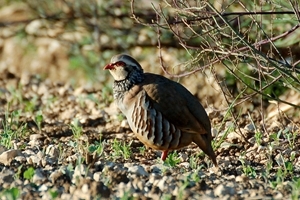 A new scientific paper in the journal Wildlife Biology came out this week (12 October), led by GWCT Head of Lowland Research Dr Rufus Sage, which delves into the effects of released pheasants and red-legged partridges on wildlife and the environment. It provides a summary review of what is and is not known and an overall analysis of whether gamebird releases are having ‘good’ or ‘bad’ effects on both the habitats around them, and the other species that share the fields and woodlands nearby.
A new scientific paper in the journal Wildlife Biology came out this week (12 October), led by GWCT Head of Lowland Research Dr Rufus Sage, which delves into the effects of released pheasants and red-legged partridges on wildlife and the environment. It provides a summary review of what is and is not known and an overall analysis of whether gamebird releases are having ‘good’ or ‘bad’ effects on both the habitats around them, and the other species that share the fields and woodlands nearby.
Although there are other reports1, this is the first peer-reviewed paper to be published on this topic. The authors used the literature itself to define important topics and then attached a simple categorisation to each (positive, neutral or negative), which could then be compared in the context of other factors such as the size of a release or the scale at which an effect might operate.
Summarising what is already a summary review into a very small nutshell: habitat management for gamebirds can have a positive ecological effect with more songbirds in game woods, as well as more bees and butterflies at their edges. Woodland is more likely to be planted or retained where gamebirds are part of the landholding, and this woodland better managed. In and very close to release pens, the pheasants themselves can have direct negative effects on plants, the soil and invertebrate communities. But there was little evidence for negative effects away from release sites, although mosses and lichens on trees may be affected away from the pen itself.
On open land, the presence of hedgerows, game crops and supplementary feeding are positive for farmland birds, but gamebirds may have a negative effect on the hedgerows themselves, as well as some impacts on invertebrates where released birds congregate, and a possible local effect on reptiles. Gamebirds tend to remain close to their release site, with 90% remaining within 1km. In general, negative habitat impacts are localised whereas benefits from habitat improvements can influence the whole woodland or farm.
The paper explores more complicated indirect issues as well, such as the potential effect of gamebird releases on predator populations, and illegal killing of birds of prey. The first of these is not yet well enough understood for conclusions to be drawn – we need more research looking at this in the context of a range of land uses (for example different livestock farming systems). The extent to which raptors are killed alongside releasing is unclear, but any cases have a clear negative effect and this must stop. Overall, assuming an average shoot in terms of both size and adherence to good practice, the review found that ecological positives and negatives are approximately balanced; with ten positive outcomes, twelve negative and three neutral.
The context for this overall finding is that any modern economic land use will have negative ecological effects, and many have relatively few positive ones. This paper finds that the balance is relatively even for release-based shooting, and the ecological seesaw can easily be tipped either way: where shoots over-stock pens, site them in particularly sensitive areas etc, more negatives may occur, but where shoots keep to appropriate stocking densities in well-sited pens, support their birds with ecologically valuable game crops for the winter and so on, the positives will outweigh the negatives and the shoot will deliver an overall biodiversity gain.
This is encouraging, as it suggests that increased awareness of the potential ecological effects, along with education around best practice guidelines, can help shoot owners improve their ecological profile with relative ease. Efforts in this area such as GWCT advisory visits, courses and publications can all help tip the balance. We don’t need leaps in technology or a complete overhaul of the sector: we already know what makes a well-run shoot, and how these can be good for the countryside. It will be no surprise to GWCT members that adhering to our published best practice guidelines and principles of sustainable game management that several of the potential negatives can be reduced or eliminated to help a shoot fulfil its potential to deliver ecological benefits.
The message is simple: a well-run shoot that is guided by best practice and abides by the law can make a positive contribution to local habitats and wildlife.
The full paper is available here.
Footnotes
1 A recent report on this issue by some of the same authors has been published recently by Natural England. It provides more detail and context, available here. Another review published as a report by the RSPB on this subject was released at the same time as this paper.